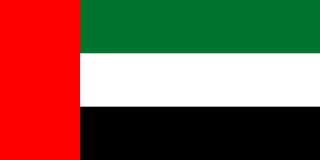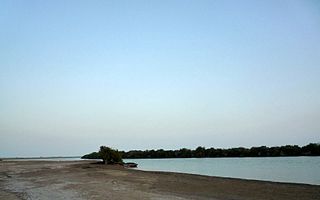
The United Arab Emirates is a country in the eastern part of the Arabian Peninsula located on the southeastern coast of the Persian Gulf and the northwestern coast of the Gulf of Oman. The UAE consists of seven emirates and was founded on 2 December 1971 as a federation, after UK armed forces left the region. Six of the seven emirates declared their union on 2 December 1971. The seventh, Ras al Khaimah, joined the federation on 10 February 1972. The seven sheikdoms were formerly known as the Trucial States, in reference to the truce treaties established with the British in the 19th century.

The flag of the United Arab Emirates contains the Pan-Arab colors red, green, white, and black. It was designed in 1971 by Abdullah Mohammed Al Maainah, who was 19 years old at that time, and was adopted on 2 December 1971 after winning a nationwide flag design contest. The main theme of the flag's four colors is the sovereignty and unity of the Arab states.

The Arab states of the Persian Gulf or the Arab Gulf states refers to a group of Arab states bordering the Persian Gulf. There are seven member states of the Arab League in the region: Bahrain, Kuwait, Iraq, Oman, Qatar, Saudi Arabia, and the United Arab Emirates. Yemen is bound to the six countries of the Gulf Cooperation Council, based on history and culture.

Kalba is a city in the Emirate of Sharjah in the United Arab Emirates (UAE). It is an exclave of Sharjah lying on the Gulf of Oman coast north of Oman. Khor Kalba, an important nature reserve and mangrove swamp, is located south of the town by the Omani border.

The Persian Gulf Residency was a subdivision of the British Empire from 1822 until 1971, whereby the United Kingdom maintained varying degrees of political and economic control over several states in the Persian Gulf, including what is today known as the United Arab Emirates and at various times southern portions of Iran, Bahrain, Kuwait, Oman, and Qatar.
The Shihuh is an Arab tribe living in the United Arab Emirates (UAE) and Oman. In the singular, the name is Al Shehhi, a common family name in the UAE and Oman today. Inhabiting the northern part of the Hajar Mountain range, specifically in the Ruus Al Jibal, the tribe has long been influential in the affairs of both the east and west coast settlements of the northern UAE and Oman and has fiercely maintained both its identity and independence.
Abu Hail is a neighbourhood in Dubai, United Arab Emirates (UAE), located in Deira. The locality is largely residential and is bordered by the localities of Al Waheda on the east, Hor Al Anz in the south and Al Baraha on the west.
The General Maritime Treaty of 1820 was initially signed between the rulers of Abu Dhabi, Sharjah, Ajman, Umm Al Quwain, Ras Al Khaimah and Great Britain in January 1820, with the nearby island state of Bahrain acceding to the treaty in the following February. Its full title was the "General Treaty for the Cessation of Plunder and Piracy by Land and Sea, Dated February 5, 1820".

The Trucial States, also known as the Trucial Coast, the Trucial Sheikhdoms, Trucial Arabia or Trucial Oman, was a group of tribal confederations to the south of the Persian Gulf whose leaders had signed protective treaties, or truces, with the United Kingdom between 1820 and 1892.

This is a survey of the postage stamps and postal history of the United Arab Emirates (UAE).
The military history of the United Arab Emirates describes the military history of the United Arab Emirates Armed Forces. Prior to the union of the emirates, different tribal confederations formed the de facto military force which was dominant in the area now known as the United Arab Emirates. The Bani Yas and Al Qawasim were the most significant of those tribal confederations. The official formation of the military began with the formation of the Truical Oman Levies by the British Empire on 11 May 1951 as the area was under a British protectorate.
The Federal Supreme Council, also known as the Supreme Council of Rulers, is the highest constitutional authority in the United Arab Emirates, being the highest legislative and executive body. It replaced the earlier Trucial States Council upon the formation of the United Arab Emirates in 1971 and establishes general policies and sanctions federal legislation. It is the highest federal authority in terms of hierarchy in the five federal authorities prescribed in the Constitution followed by the president and the vice president, federal cabinet, Federal National Council and the federal judiciary.

The Embassy of the United States in Abu Dhabi is the diplomatic mission of the United States of America in United Arab Emirates.

Sheikh Mohammed bin Hamad Al Sharqi was an Emirati royal, politician and a founder of the United Arab Emirates who served as the ruler of Fujairah from 1938–1974. In 1952 he was to see his father's long-held dream of independence for Fujairah recognised by the British, the last Trucial State to be so recognised, as well as shortly afterwards to help take the UAE to independence as a nation, in 1971. Due to his skills in diplomacy and politics he was called the wolf of the Gulf.

Ras Al Khaimah, often referred to its initials RAK and historically known as Julfar, is the largest city and capital of the Emirate of Ras Al Khaimah in the United Arab Emirates (UAE). The city had a population of 400,000 in 2023, and is the sixth-most populous city in UAE after Dubai, Abu Dhabi, Sharjah, Al Ain and Ajman. The city is divided by a creek into two parts: old town in the west and Al Nakheel in the east.

The Oman–United Arab Emirates border consists of three non-contiguous sections totalling 609 km in length.
The Perpetual Maritime Truce of 1853 was a treaty signed between the British and the Rulers of the Sheikhdoms of the Lower Gulf, later to become known as the Trucial States and today known as the United Arab Emirates. The treaty followed the effective subjugation of the Qawasim maritime federation and other coastal settlements of the Lower Gulf by British forces following the Persian Gulf campaign of 1819, a punitive expedition mounted from Bombay which sailed against Ras Al Khaimah, and which resulted in the signing of the General Maritime Treaty of 1820.
The political history of the United Arab Emirates covers political events and trends related to the history of the United Arab Emirates.

Chattel slavery existed in the Trucial States (1892–1971), which later formed the United Arab Emirates. The Trucial States consisted of the Sheikdoms Dubai, Abu Dhabi, Sharjah, Ajman, Umm Al Quwain, Fujairah, and Ras Al Khaimah. The region was mainly supplied with enslaved people from the Indian Ocean slave trade, but humans were also trafficked to the area from Hejaz, Oman and Persia. Slaves were used in the famous pearl fish industry and later in the oil industry, as well as sex slaves and domestic servants. Many members of the Afro-Arabian minority are descendants of the former slaves.














